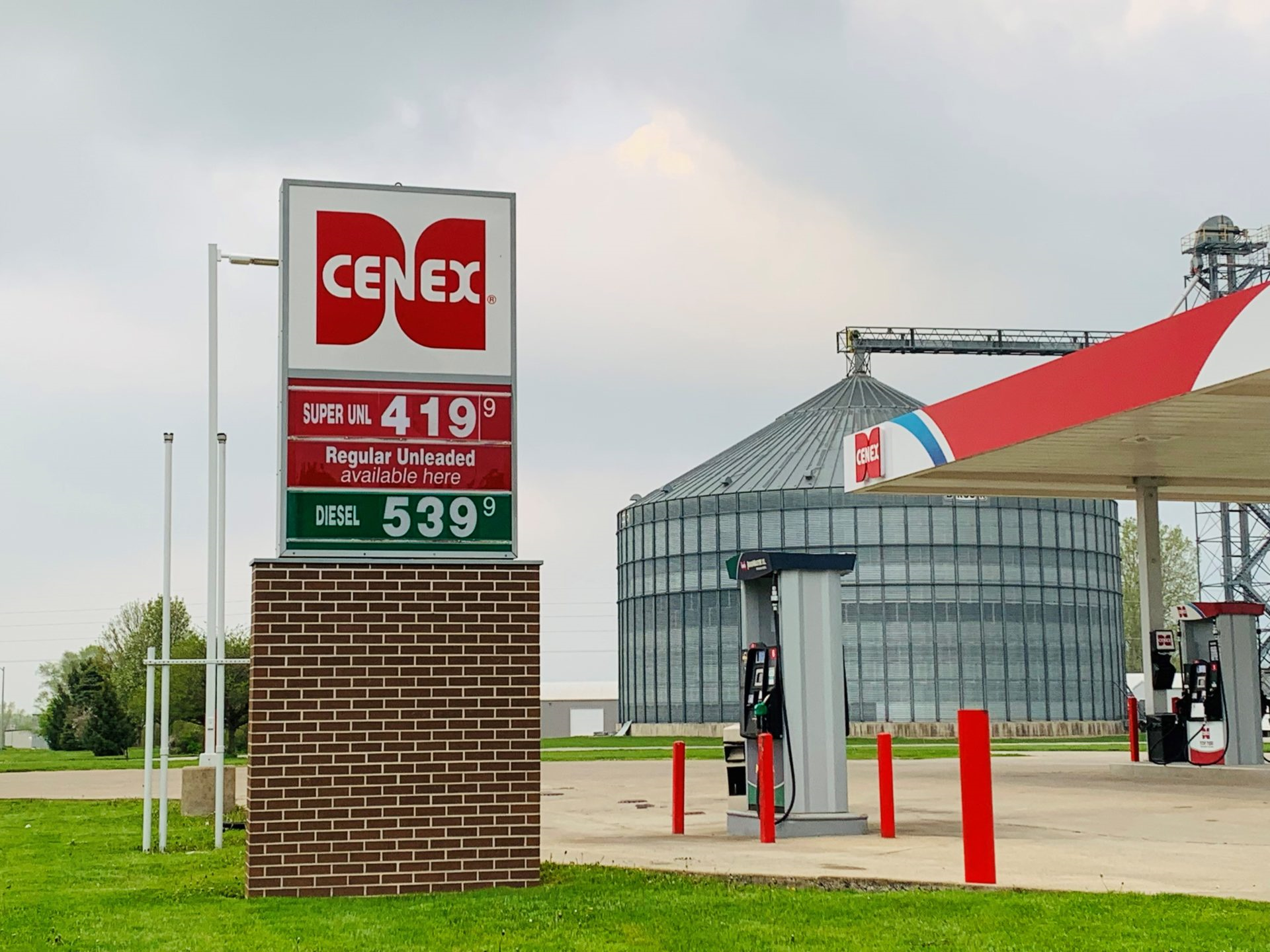Recent geopolitical tensions in the Middle East are having a direct and significant impact on fuel costs across the United States, particularly affecting diesel prices in critical agricultural regions.
A leading fuel economist has highlighted how this international instability is contributing to a notable surge at the pump. Patrick De Haan, the Head of Petroleum Analysis at GasBuddy, a widely recognized technology company that tracks real-time fuel prices across North America, reports that diesel prices have seen a swift and considerable increase in recent days. This volatility in diesel costs is directly linked to the fluctuating and often unpredictable price of crude oil on the global market.
De Haan specifically pointed out that, “In fact, diesel prices very quickly jumped 20 cents per gallon.” This rapid increase impacts various sectors, but its effect on agriculture is particularly pronounced. Across the heartland of the United States, in what is commonly referred to as the Corn Belt, the situation is even more severe.
Farmers and agricultural businesses in this vital region have experienced even steeper price hikes, with diesel costs increasing anywhere from 25 to a staggering 50 cents per gallon. This sudden and substantial rise in fuel expenses poses a direct challenge to the profitability and operational efficiency of the agricultural sector, especially as farming activities intensify during the growing season.
Understanding the Price Drivers: Geopolitics and Supply
The current surge in diesel prices is not solely attributable to global conflicts; underlying supply issues are also playing a critical role.
Middle East Volatility and Crude Oil Prices
The primary catalyst for the recent increase in diesel prices in the U.S. is the escalating geopolitical instability in the Middle East. This region is a cornerstone of global oil production, and any conflict or tension there inevitably sends ripples through the international crude oil markets. Patrick De Haan emphasized that crude oil has become highly volatile in recent days. Volatility in this context means sharp and unpredictable swings in prices, reacting rapidly to news and developments related to the conflict.
When tensions escalate, markets anticipate potential disruptions to oil supply routes, or even direct impacts on production facilities, leading to a scramble among buyers and a subsequent rise in prices.
Conversely, any signs of de-escalation, such as discussions of a ceasefire or a reduction in hostilities, can cause oil prices to plummet just as quickly. For instance, De Haan noted that oil prices had recently plummeted nearly $15 per barrel due to news concerning a “fragile cease-fire situation between Iran and Israel.” This demonstrates the immediate and profound sensitivity of global crude oil prices to even tentative peace efforts.
However, the overall uncertainty and the continuous threat of renewed conflict maintain an underlying upward pressure on prices. This unpredictable environment makes it challenging for refiners and distributors to plan, and the increased cost of crude directly translates to higher prices for refined products like diesel and gasoline. The Middle East’s role as a major oil supplier means its stability directly impacts fuel stations thousands of miles away in the American Midwest.
Critically Low Diesel Inventories
Beyond geopolitical events, another significant factor contributing to the elevated diesel prices is the domestic supply situation, specifically lower inventories. Patrick De Haan highlighted this critical point, stating that “Inventories of diesel are nearly 20% below the five-year average for this time of year.” This statistic is alarming because low inventories mean there is less buffer stock available to meet demand fluctuations or unexpected supply disruptions. When demand is steady or rises, and available supply is limited, prices naturally go up.
The impact of these low inventories is disproportionately affecting diesel compared to gasoline. De Haan explained that “Diesel is being a little bit more impacted because inventories are extremely low.” This contrasts with gasoline prices, which, while also seeing some increases, have been less dramatic. Gasoline prices, according to De Haan, have “inched up in some areas 5-to-10 cents per gallon depending on where you may be.”
The difference in impact underscores the tight supply conditions specifically for diesel. This scarcity makes diesel prices more sensitive to any additional demand or global price shifts. For industries heavily reliant on diesel, such as agriculture, trucking, and shipping, these low inventory levels represent a constant vulnerability, making them more susceptible to sudden and sharp price increases when other external factors, like Middle East conflict, come into play.
Regional Impact: The Corn Belt’s Vulnerability
The agricultural heartland of the United States, the Corn Belt, is particularly exposed to rising diesel costs, with significant implications for food production.
Disproportionate Price Hikes in Agricultural Regions
The impact of rising diesel prices is not evenly distributed across the United States. According to Patrick De Haan, while the national average for diesel saw a quick jump of 20 cents per gallon, some areas across the vital Corn Belt experienced significantly larger increases. In these agricultural regions, diesel prices soared anywhere from 25 to a dramatic 50 cents per gallon.
This disproportionate increase highlights the unique vulnerability of farming communities to fluctuations in fuel costs. The Corn Belt, stretching across states like Iowa, Illinois, Nebraska, and Indiana, is the backbone of U.S. agricultural production, heavily relying on diesel-powered machinery for virtually every aspect of farming.
The reasons for this elevated impact are multifaceted. Agricultural operations are incredibly fuel-intensive. From planting and tilling with large tractors, to irrigating fields, to harvesting crops with combines, and finally, transporting produce to markets, diesel is the lifeblood of modern farming. Unlike personal vehicles that might be able to reduce usage or switch to more fuel-efficient models, farm machinery has few alternatives.
Furthermore, rural areas, often characteristic of the Corn Belt, may have fewer fuel stations or distribution points, potentially leading to less competitive pricing or higher transportation costs for fuel delivery to these remote locations. The combination of high demand, essential usage, and potentially less competitive local markets can amplify price increases in these critical farming areas.
Implications for Farmers and Food Prices
The substantial increase in diesel prices in the Corn Belt carries significant implications, not only for individual farmers but potentially for consumers as well. For farmers, fuel is a major operating expense, sometimes second only to land costs and fertilizers. A sudden jump of 25-50 cents per gallon directly translates to hundreds, if not thousands, of dollars in additional costs for a typical farm operation over a planting or harvesting season.
This directly impacts their profitability and can squeeze already tight margins. Farmers may have to absorb these higher costs, or, if possible, pass them on further down the supply chain.
If higher fuel costs are indeed passed on, they could contribute to increased food prices for consumers. Every step of the food supply chain, from growing and harvesting to processing, packaging, and transporting, relies on energy, much of it derived from diesel. Higher diesel prices for tractors, combines, and delivery trucks ultimately factor into the final cost of food products. This means that geopolitical tensions thousands of miles away can directly affect the price of groceries in American supermarkets.
Furthermore, unexpected cost increases can make it challenging for farmers to plan and budget, potentially impacting investment in new equipment or practices. The ripple effect of elevated diesel prices in the Corn Belt underscores the interconnectedness of global events, energy markets, and the everyday economy, highlighting the critical role of stable fuel prices for food security and economic stability.
Comparison with Gasoline Prices: The Diesel Disparity
While both gasoline and diesel are refined from crude oil, their distinct market dynamics and inventory levels are causing them to behave differently in the current environment.
Diesel’s Greater Sensitivity to Inventory Levels
One of the key insights provided by Patrick De Haan is the significant disparity in how diesel prices are reacting compared to gasoline prices. De Haan explicitly states that “Diesel is being a little bit more impacted because inventories are extremely low.” This highlights a fundamental difference in the market dynamics of these two crucial fuels. While both are products of crude oil refining, their storage levels and demand patterns are distinct.
Diesel, often referred to as distillate fuel oil, is essential for freight transportation, agriculture, industrial machinery, and even some heating applications. Its demand is often less elastic than gasoline, as businesses rely on it for core operations, making them less able to reduce consumption in response to price hikes.
Conversely, gasoline prices have seen comparatively smaller increases, typically “inching up in some areas 5-to-10 cents per gallon depending on where you may be.” This suggests that while crude oil volatility affects both, gasoline inventories might be relatively healthier, or its demand patterns allow for more flexible responses to price changes from consumers.
The lower diesel inventories mean that any disruption to supply, or any sudden increase in demand, will have a more immediate and amplified effect on its price. This makes the diesel market inherently more sensitive to external shocks like geopolitical tensions, as there’s less buffer to absorb the impact of reduced supply or increased demand.
Strategic Importance of Diesel
The current disparity in price increases underscores the strategic importance of diesel in the national and global economy. While consumers often focus on gasoline prices due to their direct impact on daily commuting, diesel is the lifeblood of commerce and critical infrastructure. It powers the trucks that transport goods across the country, the trains that move bulk commodities, the ships that import and export goods, and the heavy machinery used in construction, mining, and agriculture. A significant and sustained increase in diesel prices can therefore have a cascading effect throughout the economy.
Higher diesel costs translate to higher operating expenses for nearly every industry involved in the production and distribution of goods. This can lead to increased transportation costs, which are then passed on to consumers in the form of higher prices for goods and services. Moreover, the agricultural sector’s heavy reliance on diesel means that these price spikes directly threaten food production costs.
The current situation serves as a stark reminder that while gasoline prices might grab headlines for individual consumers, the stability of diesel prices is arguably more critical for the broader economic health and the smooth functioning of supply chains. The lower inventories for diesel, coupled with its indispensable role, make it a focal point of concern during periods of global energy market volatility.
Future Outlook and Market Dynamics
The immediate future of diesel prices remains uncertain, heavily influenced by geopolitical stability and supply chain management.
Fragile Ceasefire and Market Sensitivity
The recent plummet of nearly $15 per barrel in oil prices serves as a stark illustration of the market’s extreme sensitivity to geopolitical developments, particularly those concerning the Middle East. Patrick De Haan explicitly linked this drop to the “fragile cease-fire situation between Iran and Israel.” This demonstrates that any perceived reduction in tensions or a move towards de-escalation can trigger an immediate and significant price correction in the global crude oil market. Investors and traders react swiftly to news, betting on whether supply will be more secure or disrupted.
However, the term “fragile” is key. A fragile ceasefire implies that the situation remains precarious and could quickly revert to conflict. If the ceasefire were to break down or tensions were to escalate once more, the gains seen from the price drop could be quickly reversed, sending crude oil prices – and subsequently diesel prices – soaring again.
This inherent instability makes long-term forecasting challenging. The market remains on edge, highly responsive to every news report and diplomatic maneuver in the region. This means that businesses and consumers reliant on diesel will need to remain vigilant, as price stability is closely tied to the volatile geopolitical landscape, making it difficult to predict sustained trends.
Inventory Management and Demand
Looking ahead, the long-term trajectory of diesel prices will depend not only on geopolitical stability but also on fundamental supply-demand dynamics and inventory management. The current state of diesel inventories being nearly 20% below the five-year average is a persistent underlying concern. Even if Middle East tensions were to fully subside, these low inventory levels mean that the market remains tight and vulnerable to any unexpected surge in demand or minor supply disruptions.
Industry efforts to replenish these inventories will be crucial. Refineries need to maintain high utilization rates to produce more distillate fuels, and logistics chains must operate efficiently to move diesel to where it’s needed most. Seasonal demand also plays a role. As the summer travel season progresses, and particularly moving into the fall harvest season in agricultural regions, demand for diesel typically rises. If inventories remain stubbornly low heading into periods of peak demand, further price increases could be inevitable.
Therefore, while geopolitical calm can offer temporary relief, sustainable price stability for diesel will ultimately require a robust rebuilding of inventory levels to create a more resilient supply chain capable of absorbing shocks. The current situation is a critical reminder of the delicate balance between global politics, supply chain efficiency, and domestic fuel costs.
The Ripple Effect of Global Instability
The recent sharp increase in Corn Belt diesel prices, as highlighted by GasBuddy’s Patrick De Haan, is a clear manifestation of how distant geopolitical conflicts can directly impact local economies and critical sectors. The confluence of volatile crude oil prices, driven by the fragile Middle East conflict, and critically low domestic diesel inventories has created a perfect storm for price surges.
While gasoline prices have seen milder increases, the disproportionate jump in diesel costs underscores its essential role in industries like agriculture and transportation, making these sectors particularly vulnerable. The current situation demands close monitoring of international relations and domestic fuel supply.
Ultimately, sustainable price stability for diesel will hinge on both geopolitical de-escalation and a strategic rebuilding of fuel reserves, ensuring that vital economic activities can continue without facing crippling energy costs. The present scenario serves as a powerful reminder of the intricate global supply chains and their profound influence on everyday expenses.








